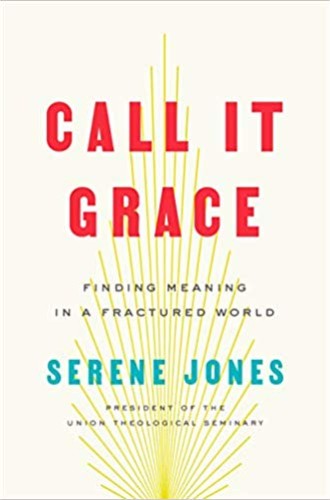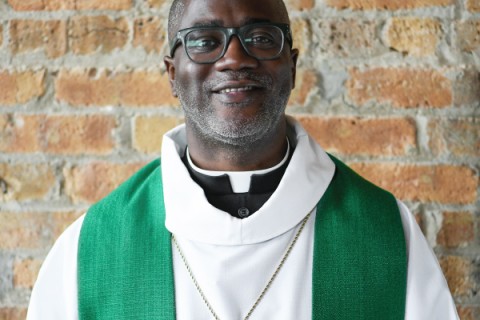Serene Jones’s memoir poses as many theological questions as answers
Theology is story, and Jones is a rousing storyteller.
Our world seems more fractured than ever: the economic gap between rich and poor yawns into a bottomless abyss, the divisions between racial and ethnic groups grow sharper, and the differences between political parties have grown into deep rifts between individuals who work for themselves rather than the common good. In such a world, Serene Jones wonders, where can we find hope?
Call It Grace is part theological exploration and part memoir. Jones poignantly reveals her own struggles to make meaning out of those times when life falls apart, when it looks as if evil has won the day, as well as to embrace the goodness and beauty that peek through such events. She shows how grace and love can illumine journeys even through paths littered with the shattered bodies and souls of families, friends, and strangers.
Jones recognizes that theology is story, and she’s a rousing storyteller. With vivid honesty, she tells of her grandfather’s racism, her mother’s spitefulness and vanity, her own divorce and near-death experience, and her challenges as president of Union Theological Seminary. As she shares these stories, she weaves in theological insights from a range of thinkers: John Calvin, Kierkegaard, Luce Irigaray, James Baldwin, James Cone, Teresa of Ávila, Katie Cannon, and many others. Jones divides the book into four “stations” that correspond roughly to the stages in her theological journey.
The first stage, “Sin and Grace,” focuses on the lessons she’s learned from Calvin. After her grandmother shows her a dusty and well-worn copy of the Institutes that had belonged to her grandfather, Jones loses herself in Calvin’s writing and discovers the teaching that stays with her. “Calvin believed that we are remarkable creatures, capable of great love and stunning feats of intellect and invention. . . . We are also the opposite of this. We are fragile and fearful creatures. . . . We are strangely drawn toward things that are not good for us, evil things.”
At the second station, “Destiny and Freedom,” Jones writes about her experiences with racism and other forms of injustice. She discovers the pull of inherited prejudice one day when her father drives her and a group of friends to the public pool to celebrate her birthday. When they see that the pool is closed, they drive to another pool in the African American part of town. Before they get there, Jones exclaims that she doesn’t want to swim with black people.
Reflecting on this incident, Jones recognizes that although she “hadn’t chosen to inherit the embodied legacy of white supremacy,” she had “chosen to please the crowd [her friends] by enacting it.” Her father, a pastor who models openness and love for all people, rebukes her sternly in the moment. The next day she learns from “his softer, contemplative side” that although he hasn’t forgotten, he has forgiven her. She glimpses grace.
In the third stage, “Hatred and Forgiveness,” Jones describes the difficulty of coming to terms with her family’s proximity to Oklahoma City’s Murrah Federal Building the day it’s bombed and later grappling with her feelings about the execution of the bomber, Timothy McVeigh. She muddles through a divorce and the complications of parenting afterward. As she struggles to forgive, Jones discovers why forgiveness is so hard:
It wasn’t because forgiveness lets people off the hook. . . . We can forgive and still hold people accountable. What makes forgiveness hard is its demand that we give up the snuggly warm blankets of hate we believe will protect us from future harm. . . . To forgive is to let go of what weighs us down so that we are freed to do the work of love in the world. Freed also to let ourselves be loved.
She also reflects on a trip to India, where, after a debilitating illness, she discovers that “faith and the dark night of the soul are inseparable.” She explains that until you can “consider the possibility that the life markers we hold most dear, even our souls, are mere grass, then whatever faith you think you may have is just one more game you’ve conceded to play without questioning.”
At the fourth station, “Redeeming Life and Death,” Jones contemplates the pillars of her faith and life. “Breath, justice, mercy, and love are the most vivid manifestations of my hungry, urgent theological imagination. When I see God, my imagination beholds the transformative power of these four sacred truths flowing through me and through the world around me.” Although Jones calls them pillars, they function also as threads—weaving in and around one another to form a quilt whose patches reveal the patterns of God’s grace. “Grace sums up all these sacred truths in one word,” she explains. “The light that shines on all existence is the light of love from beginning to end; it is the truest reality there is, our most natural impulse, our core, and our creative expression. You do not have to earn it and you can’t lose it. It just is: God.”
Jones tells riveting stories of life and faith. But she also admits that no matter how many stories we tell or how well we tell them, at the end of the day they might be tossed away as mere entertainments. Our life stories take on lasting meaning, she says, only when we connect them to the biggest questions:
So what? What do these stories tell us about ourselves and the purpose of our lives? What do our endless dramas reveal about our nature? What do they reveal about the possibility, the necessity, the reality of the divine? So what do they show about the future of our lives together? The fate of our planet? The intractable fact of suffering? The insistent corruptions of power? The sins we inherit? The glories we have yet to claim?
Jones urges her readers to dare to ask the difficult questions, as she so compellingly asks in the book. If we do, we just might “find our theological anchors,” see ourselves as we really are, and glimpse the grace that runs through the ragged and worn fabric of our society.






